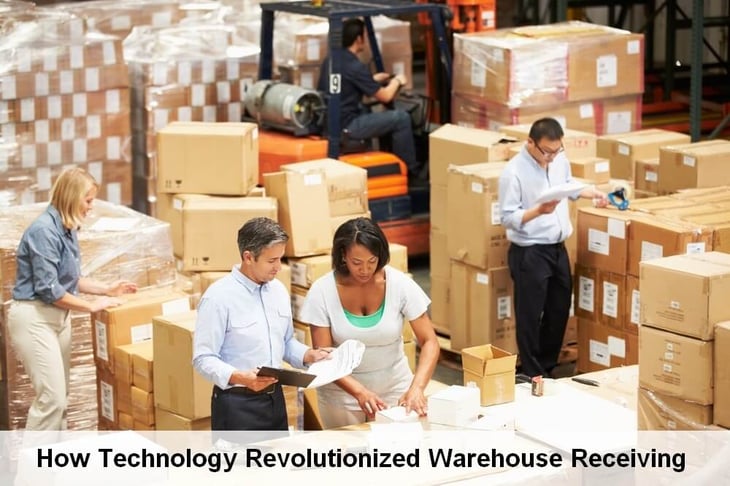
Over the last few years, warehouse technology has seen some major shifts. Some of these have entered the scene with a bang, and others have been more subtle but will have major effects in the future. As warehouse managers adjust to the new mobile, connected world, they have to consider many different aspects including cost of the technology, relevance to their business and how it will improve any or all parts of the process.
Perhaps the most important part of this process is receiving. It is the first point of contact for all merchandise, and every step of the downstream process depends heavily on accuracy in receiving. If a pallet or container is improperly labeled or received, the entire process suffers. This means loss of money, time and productivity.
When all is said and done, warehouses are all about productivity, and any new technology that can improve this is something that should be embraced. However, many warehouses have been very slow to the party when it comes to integrating new technologies into their system.
This is partly because warehouses have very complex, inter-connected processes, and any new technology-- whether in receiving or any other step of the way-- would need to be integrated into the entire system. They continued to use outdated methods as opposed to trying to bring in an entirely new cog into the wheel.
But over the last five years, receiving and warehouse management as a whole have seen some revolutionary changes. Mobile technologies, cloud integration, voice application and other new aspects have changed the way warehouses receive, store and ship merchandise. In addition to new technologies, older processes like barcoding inventory management have been updated to keep up. In this article, we will explain some of the new technologies that have changed warehouse receiving, why they are necessary and what triggered the acceptance of these new processes.
Warehouse Receiving Has Changed
For decades, the process of receiving, storing and shipping was done basically the same way for all warehouses. Small improvements may have appeared, but for the most part, warehouse receiving consisted of time-consuming manual labor. The items were received and documented manually, and they were sent to their storage areas and shipped in a similar manner.
Then sweeping changes happened in commerce and logistics that forced warehouse managers to rethink processes. The biggest change was the prevalence of the internet and online shopping. A new word, “eCommerce,” entered our vocabulary and changed everything about the business. The world started moving faster and faster, particularly in the commercial sector, and anyone not fast enough to keep up would be left behind for good.
Merchants and warehouses were forced to update their methods and embrace new ideas, or they would quickly be left for a better option. New technology began to evolve that allowed the advancement of eCommerce business models, and warehouses were forced to scramble to keep up with industry changes.
In the last few years, the most successful warehouse companies have been the ones that are able to quickly keep up with these changes and embrace the new technologies. They are forced to upgrade for greater efficiency, higher reliability and become a better fit for both customers and merchants.
Why It is Important to Embrace New Technologies
The most productive warehouse receiving policy of today revolves around a “one touch” mentality. The more times an item is handled and the more people involved in the handling, the longer the process will take and the more opportunities for mistakes and inaccuracies. Modern warehouses have adopted new methods and technologies that allow for one person to receive, scan and check off received materials before sending them to the appropriate place for stocking.
There are many reasons why it is important for modern warehouses to embrace new ideas and technologies, but they can be broken down into three main areas.
- Cost Effective: The more warehouse workers involved in the receiving process, the more it will cost for the company. With the technologies that are currently available, the involvement of multiple workers in the process is unnecessary and increases operating costs. The presence of modern technology in receiving reduces the need for more than one warehouse employee to be present during the time of shipment receiving, and enables managers to reassign workers to better uses based on their current needs.
- Time Efficient: In the past, it was not uncommon for materials received in a warehouse to be handled by multiple workers, but constantly handing off items only increases the amount of time it takes to reach its final destination. Advanced receiving technology allows for a single worker to scan and check in a shipment, and it can then be immediately moved to its designated spot.
- Accuracy: The manual receiving methods of the past are not only outdated, they also run a much higher risk of mistakes and inaccuracies. This is even more true when shipments are handled by many different people within the warehouse. One of the best and most efficient ways technology can improve receiving productivity is by delivering higher rates of accuracy for the inventory. When shipments are received, they can be automatically scanned and entered into the system. Then a log will keep track of where items move and are stored throughout the entire warehouse.
How Technology Helps Respond to the Demand
With eCommerce becoming more and more prevalent in our society, warehouses are beginning to grow in importance. For most of the last century, warehouses have been seen as a boring, necessary place where items were stored and shipped by the usual methods. Now as customers expect merchandise more and more quickly, and in larger quantities, merchants are beginning to realize the importance of a good warehouse.
Warehouses have now become a crucial component for retailers, suppliers, manufacturers and other types of businesses as everyone competes to become faster and more efficient. The best warehouses have now added new elements of technology that allows for more accurate receiving, better storage inventory and faster shipping. The importance of an efficient warehouse has become more important than ever thanks to the changing market, and the first step in all of this is receiving department.
The Technologies of Modern Receiving
While new software, hardware and other technologies are being developed for warehouse management every day, these are a few of the best technologies in the warehouses of today.
- Cloud-based Technologies: Many warehouses were slow to adopt cloud technologies due to perceived security concerns and the lack of others in the industry using the technology. But now many software companies are developing applications specifically for warehouse receiving and inventory that can be accessed via the cloud. They can be accessed on smartphones, tablets and computers, making this a highly versatile solution.
- Voice Technology: One of the greatest new concepts that improves efficiency and makes work easier for the staff is voice technology. Warehouse workers are now able to use their voices to quickly pick, pack, replenish and ship merchandise.
- Mobile Devices: For many years, the only handheld devices in warehouses were the old-fashioned barcode scanners. While many warehouses still use these devices, many are now adopting a better method using smartphones and tablets. Now workers can scan items, place them and track them all from one device.
- RFID: Radio frequency identification technology (RFID), also known as Automatic Identification (AutoID) is a new automated data collection system that shows a lot of promise in warehouses. Although it consists of several different components, this new technology could be most beneficial in receiving. It allows for items to be automatically scanned in larger volumes-- and at higher speeds-- than any other method available. This can also help reduce costs, streamline processes and increase accuracy in all areas of the warehouse. It has just recently emerged as a possible solution for warehouses but does show great promise and could be the way of the future.
- Mobile Workstations: One of the most innovative and practical solutions in modern warehouse receiving is the mobile workstation. These portable computers allow for employees to take the system with them all over the warehouse and take every step of the process in one trip. This helps to significantly boost dock to stock time as well as reduce labor costs. The ability to take the workstation anywhere the employee is working also greatly reduces the chances of mislabeled products, inaccurate inventories and other possible mistakes.
Summary
While not all of these technologies are currently used in all warehouses, there are clear signs that they are the way of the future. With the changing market, warehouse managers will take any necessary steps to keep up. Cloud technologies, automation, mobile devices and other new technologies would allow them to do just that by increasing productivity as well as reducing costs at the same time. The first step in any of this starts in the receiving department. Technologies that allow for great accuracy, better placement, and quicker dock to stock time will help to streamline every area of the warehouse and create a more productive environment.
